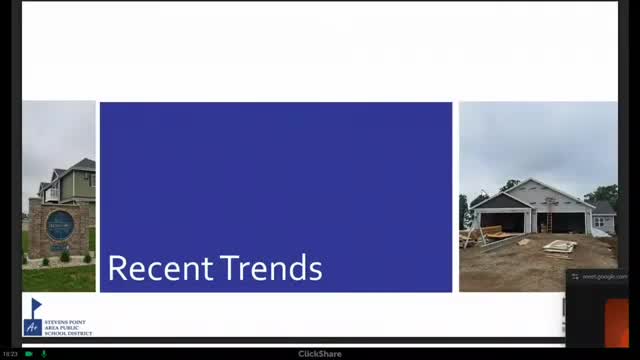Consultant projects modest decline through 2040, urges long-range facilities planning
November 11, 2025 | Stevens Point Area Public School District, School Districts, Wisconsin
This article was created by AI summarizing key points discussed. AI makes mistakes, so for full details and context, please refer to the video of the full meeting. Please report any errors so we can fix them. Report an error »

Nick Johnson, a planner with MD Roppers Consulting, told the Stevens Point Area Public School District board that the district’s enrollment has declined and demographic trends mean the district should plan for a smaller student population through 2040.
"Enrollment decreased by about 320 students or about 4% over the past decade," Johnson said during his presentation, which the board received on Nov. 10. He told the board births in the district fell from roughly 618 in 2010 to about 451 in 2023 and that housing type matters: new single-family homes generate roughly 0.5 students per unit while new apartments generate far fewer.
Johnson said the firm projects about 3,800 new housing units in the district by 2040 but nonetheless forecasts a net enrollment decline of about 470 students by 2040, roughly 30 students per year on average. "By 2040, we do project a decrease of about 470 students," he said.
Why it matters: the projected declines are not evenly distributed across the district. Johnson’s slides show the most elementary enrollment losses are likely at Madison, McKinley and Roosevelt elementaries, while Plover Whiting Elementary is expected to grow substantially because of concentrated housing development in that attendance area.
Johnson walked the board through methodology details—90 neighborhood geographies; student-per-housing-unit ratios derived from student address data; projections that account for births, household age structure, home sales and new housing supply—and the differences in student generation among housing types. He said two-thirds of projected new units will be duplexes or other multiple‑family units, which typically produce fewer students than single-family homes.
Board response and next steps: district leaders said they will review the full 122‑page report and return with recommendations in January. Superintendent Corey said the administration will consider whether to form a board‑appointed citizen task force and proposed that the district begin a long-range facilities planning process to address uneven building capacity and the possibility of consolidations or phased actions.
What the consultant recommended: Johnson recommended starting a formal long-range facilities plan that could include a citizen task force, phased options for building use and capacity management, and community engagement. The administration agreed to bring suggested next steps to the board in January.
"Enrollment decreased by about 320 students or about 4% over the past decade," Johnson said during his presentation, which the board received on Nov. 10. He told the board births in the district fell from roughly 618 in 2010 to about 451 in 2023 and that housing type matters: new single-family homes generate roughly 0.5 students per unit while new apartments generate far fewer.
Johnson said the firm projects about 3,800 new housing units in the district by 2040 but nonetheless forecasts a net enrollment decline of about 470 students by 2040, roughly 30 students per year on average. "By 2040, we do project a decrease of about 470 students," he said.
Why it matters: the projected declines are not evenly distributed across the district. Johnson’s slides show the most elementary enrollment losses are likely at Madison, McKinley and Roosevelt elementaries, while Plover Whiting Elementary is expected to grow substantially because of concentrated housing development in that attendance area.
Johnson walked the board through methodology details—90 neighborhood geographies; student-per-housing-unit ratios derived from student address data; projections that account for births, household age structure, home sales and new housing supply—and the differences in student generation among housing types. He said two-thirds of projected new units will be duplexes or other multiple‑family units, which typically produce fewer students than single-family homes.
Board response and next steps: district leaders said they will review the full 122‑page report and return with recommendations in January. Superintendent Corey said the administration will consider whether to form a board‑appointed citizen task force and proposed that the district begin a long-range facilities planning process to address uneven building capacity and the possibility of consolidations or phased actions.
What the consultant recommended: Johnson recommended starting a formal long-range facilities plan that could include a citizen task force, phased options for building use and capacity management, and community engagement. The administration agreed to bring suggested next steps to the board in January.
View full meeting
This article is based on a recent meeting—watch the full video and explore the complete transcript for deeper insights into the discussion.
View full meeting
